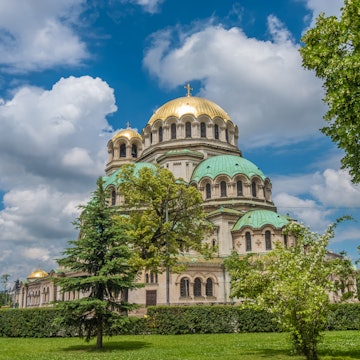

Sandstone pyramids rising over traditional houses in Melnik © Dimitar Sotirov / Shutterstock
In the heart of Bulgaria, rivers thrash out saw-edged canyons and mountains spear the clouds. Hiking in this Balkan country, you can witness astonishing geological variety: blue-hued caves, peaks pushing almost 3000m high, and sandstone pyramids straight out of a Salvador Dalí painting.
So stretch your calves and free up some space on your camera’s memory card. This primer will set you trekking around Bulgaria towards five of its most rockin’ views.

1. Wander among Melnik’s sandstone pyramids
Bulgaria’s smallest town, just 20km north of the Greek border, has two claims to fame: its vineyards, and their dramatic setting among natural sandstone pyramids. Sipping on Melnik’s rich wine immeasurably enhances the view.
The town is an architectural reserve, dotted with churches, a ruined fortress and a 19th-century bathhouse. Even brand-new buildings follow the 18th-century style of Melnik’s historical mansions, with overhanging upper floors and pastel-coloured facades.
Equally lovely is the backdrop of undulating sandstone. Melnik’s rock formations ripple across 50 sq km. Sculpted by wind and frost, some of these fang-shaped towers reach as high as 100m. You can admire the dusty monoliths on casual rambles around the town, but Melnik’s surrounding hills offer the most spellbinding views.
Hike it: The 7km walk between Melnik and Rozhen Monastery has great views, but dedicated hikers see Melnik as the finishing line for multi-day treks in the Pirin Mountains. It’s roughly a six-hour descent from Pirin Hut to Melnik, after which you’ve truly earned a brimming glass of Melnik wine.

2. Discover revolutionary hideouts in Blue Rocks Nature Park
On the other side of the Stara Planina mountain range lies Sliven, gateway to boulder-strewn Blue Rocks Nature Park. Despite the name, you’d have to look hard to see more than a bluish haze here (thought to originate from a concentration of quartz). But the rocks’ secrets are more compelling than their hue: this area simmered with revolutionary spirit ahead of Bulgaria’s April 1876 Uprising.
The country was locked under Ottoman control for nearly 500 years, and thirst for revolution intensified towards the end of the 18th century. Sliven became a stronghold for freedom fighters, known as haidouks, who gathered in the Blue Rocks caves to whisper their plans to oust the Ottomans.
For some patriotic Bulgarians, trekking in Blue Rocks Nature Park is almost a pilgrimage. Listen closely and you can almost hear the haidouks’ muffled footsteps, and the clank of a musket being loaded...
Hike it: Take the chairlift to the top of Blue Rocks Nature Park and follow the pathway to the road before walking through the forest for about 500m. Heading downhill from here, you’ll see signposted trails to the caves (less than two hours’ circuit). If you still have energy, you can skip the return chairlift journey and walk down to the lower station (about an hour).
Read more: Skiing, hiking, climbing, rafting and more: finding adventure in Bulgaria

3. Admire Zabardo’s "Marvellous Bridges"
Wind, rain and the thundering Erkyupryia River have created some surprising sculptures in Bulgaria’s Rodopi Mountains. None is more magical than the natural arches near Zabardo village, a 30km drive north and west from skiing hub Chepelare.
Dubbed the "Marvellous Bridges", these three rock formations – perched at an altitude of 1450m – instantly impress. Of the two that are accessible to visitors, the larger reaches 45m high.
Framed by towering spruce trees, these spectacular spans have inevitably attracted myths and legends. One favourite yarn is that the bridges were blown out of the rock by a dragon, who was tricked by local shepherds into eating an ammunition-packed donkey. It’s a colourful image to ponder along trails that bypass caves and hundred-year-old evergreens.
Hike it: Take a meandering north–south trail between Orehovo and Zabardo villages, passing the Marvellous Bridges. The hike can take over eight hours in total, but it’s possible to split the journey by overnighting at the hikers’ hut near the bridges.
Read more: Skiing in Bulgaria: a beginner's guide to Bansko

4. Explore dramatic Emen Canyon
With its sharp cliffs and wild forest, Emen Canyon is a true highlight of Bulgaria’s central mountains. Barely 22km west of Bulgaria’s former royal capital, Veliko Târnovo, the Negovanka River continues to shape this majestic canyon, carving out limestone crags and bursting forth as occasional waterfalls.
From Emen Cave, scramble up a steep rocky trail to the clifftop. From here you can walk along the edge of these 90m-high cliffs, listening to the rushing water, before the path meanders into woodland. Half an hour along this tree-shaded path is a muddy descent to Momin Skok, a 10m-high waterfall where, according to local lore, three Bulgarian women drowned themselves to avoid capture by the Ottomans. In Bulgaria, it seems, dark history and natural beauty go hand in hand.
Hike it: A two-hour trail starts at the north end of Emen village, leading past the cave and along the cliffs. Follow the faded eco-trail signposts but avoid the poorly maintained wooden ladders.

5. Roam Martian landscapes in Stob
Sixty kilometres south of capital Sofia, the Rila Mountains conceal Bulgaria’s most sacred sight. Millennium-old Rila Monastery is considered the country’s soul; but beyond the billowing incense and black-clad monks, these valleys take on an unearthly quality.
Just 5km south of Rila, the horizon seems to blaze with burnt orange sandstone. Rocky steeples rise above the village of Stob, some as tall as 12m, while clefts in these reddish hills plunge 40m deep.
Just as strange as their appearance are the myths inspired by Stob’s pyramids. One popular folk tale explains these statuesque rocks as the petrified remains of a wedding procession that froze in astonishment after a guest stole a kiss from the bride-to-be. Gazing out at this auburn forest of stone, you might feel rather stunned yourself.
Hike it: A scenic hour-long eco-trail extends from the Stob pyramids car park (signposted in Stob village) to the highest vantage point over this Martian landscape. It’s an easy trail, though a little steep in places, with plenty of lookouts over the tapestry of farmland below.














